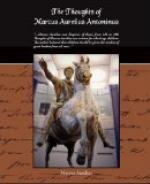The war on the northern frontier appears to have been uninterrupted during the visit of Antoninus to the East, and on his return the emperor again left Rome to oppose the barbarians. The Germanic people were defeated in a great battle A.D. 179. During this campaign the emperor was seized with some contagious malady, of which he died in the camp at Sirmium (Mitrovitz), on the Save, in Lower Pannonia, but at Vindebona (Vienna), according to other authorities, on the 17th of March, A.D. 180, in the fifty-ninth year of his age. His son Commodus was with him. The body, or the ashes probably, of the emperor were carried to Rome, and he received the honor of deification. Those who could afford it had his statue or bust; and when Capitolinus wrote, many people still had statues of Antoninus among the Dei Penates or household deities. He was in a manner made a saint. Commodus erected to the memory of his father the Antonine column which is now in the Piazza Colonna at Rome. The bassi rilievi which are placed in a spiral line round the shaft commemorate the victories of Antoninus over the Marcomanni and the Quadi, and the miraculous shower of rain which refreshed the Roman soldiers and discomfited their enemies. The statue of Antoninus was placed on the capital of the column, but it was removed at some time unknown, and a bronze statue of St. Paul was put in the place by Pope Sixtus the fifth.
The historical evidence for the times of Antoninus is very defective, and some of that which remains is not credible. The most curious is the story about the miracle which happened in A.D. 174, during the war with the Quadi. The Roman army was in danger of perishing by thirst, but a sudden storm drenched them with rain, while it discharged fire and hail on their enemies, and the Romans gained a great victory. All the authorities which speak of the battle speak also of the miracle. The Gentile writers assign it to their gods, and the Christians to the intercession of the Christian legion in the emperor’s army. To confirm the Christian statement it is added that the emperor gave the title of Thundering to this legion; but Dacier and others, who maintain the Christian report of the miracle, admit that this title of Thundering or Lightning was not given to this legion because the Quadi were struck with lightning, but because there was a figure of lightning on their shields, and that this title of the legion existed in the time of Augustus.
Scaliger also had observed that the legion was called Thundering ([Greek: keraunobolos], or [Greek: keraunophoros]) before the reign of Antoninus. We learn this from Dion Cassius (Lib. 55, c. 23, and the note of Reimarus), who enumerates all the legions of Augustus’ time. The name Thundering of Lightning also occurs on an inscription of the reign of Trajan, which was found at Trieste. Eusebius (v. 5), when he relates the miracle, quotes Apolinarius, bishop of Hierapolis, as authority for this name being




